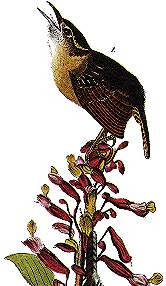Carolina wren
http://www.50states.com/bird/carwren.htm

"When satiated with food, or fatigued with these multiplied exertions, the
little fellow stops, droops its tail, and sings with
great energy a short ditty something resembling the words come-to-me,
come-to-me, repeated several times in quick succession, so loud, and yet so
mellow, that it is always agreeable to listen to them. During spring, these
notes are heard from all parts of the plantations, the damp woods, the swamps,
the sides of creeks and rivers, as well as from the barns, the stables and the
piles of wood, within a few yards of the house. I frequently heard these Wrens
singing from the roof of an abandoned flat-boat, fastened to the shore, a small
distance below the city of New Orleans."
http://faculty.maryvillecollege.edu/crain/ornithology/Anne%20Marie/great_carolina_wren.htm
Behavior
The flight
pattern of the Carolina wren is on of short wing strokes.
The tail is usually held erect, and movements are rapid and jerking, almost
mouse-like. At times, an individual may
perch with the tail drooped and sing a full song
resembling a full, yet mellow "come-to-me, come-to-me" phrase.
This is in contrast to the firmer "chirr-up," which may be heard
throughout foraging. Songs may be heard throughout the
day, even after sunset. The commonly heard "tea-kettle,
tea-kettle, tea-kettle" phrase may be heard below. Males
call year round, although winter calls are much less extravagant than are the
songs of the mating season.
The general habitat includes areas of marsh or successional scrub vegetation,
and are often located near bodies of water. A very
resourceful bird, Carolina wrens will extend habitat to barns, woodpiles, and
suburban areas.

